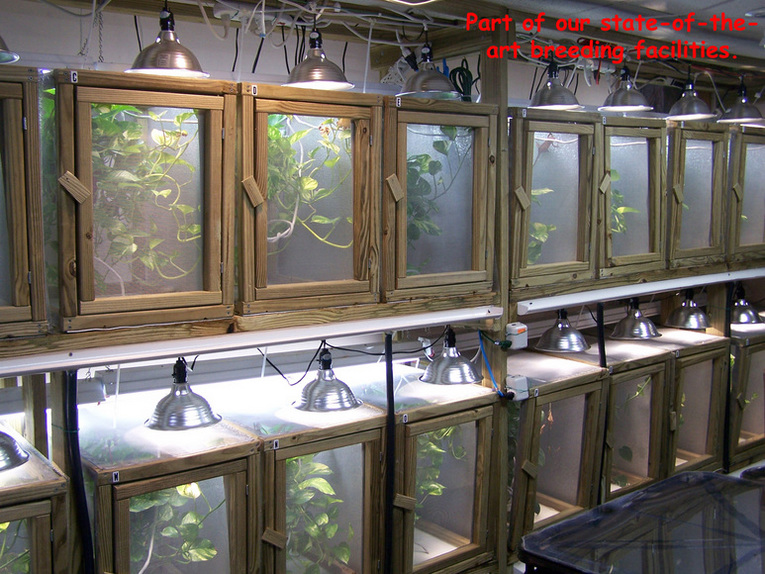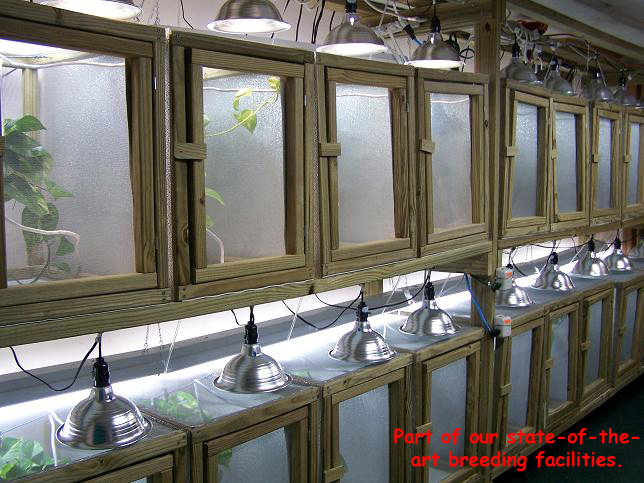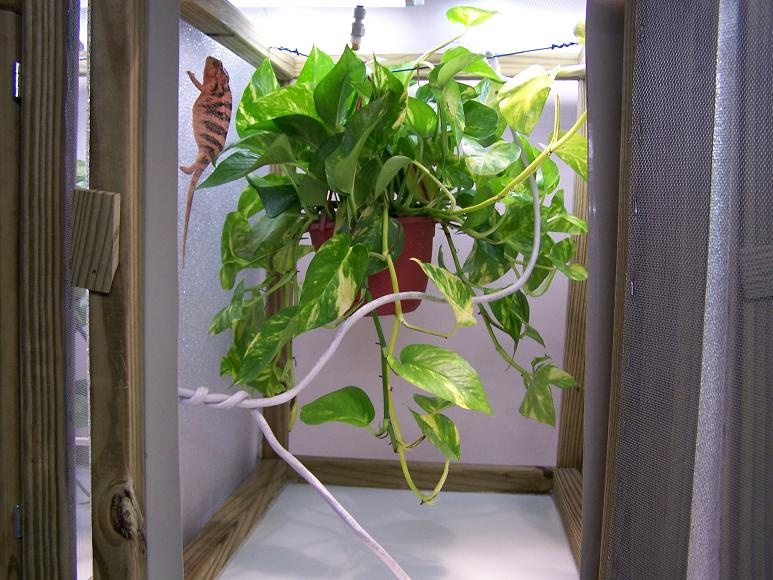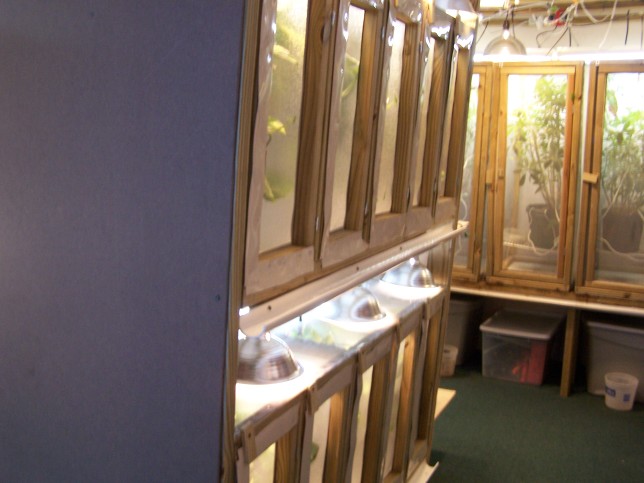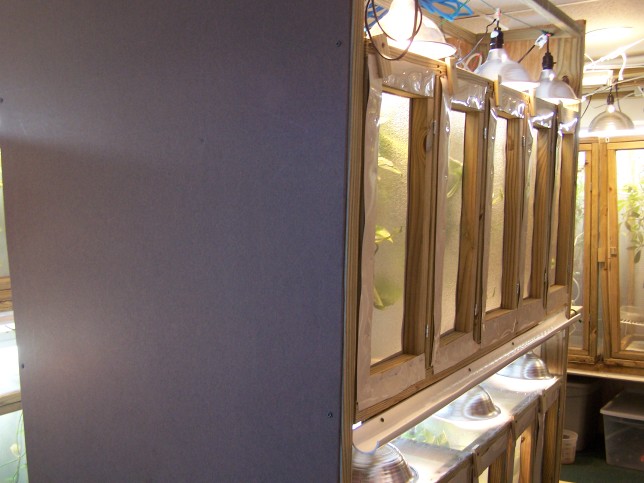

 |
Also Visit:
The Snail Tail Conservation Effort
|
Cage Setup Considerations:
Due to many recent questions about my cage setups, and building cage setups in general, I decided to post a short DIY on this subject. These cage setups can range from something as simple as 4 cages, to something as immense as 50 cages (or even larger). They are relatively cheap if you consider how much each individual cage costs, but the total price of the project can be quite high. Here are some of my cage setups that might give you ideas…
I prefer to build my own cages because it is a very fun and knowledgeable experience, and I also build them perfectly to fit within the amount of space I am working with. Here are some pictures of cages that I built individual and put on a big rack made out of 2x4s. This is a very good idea because the cages can be moved outside for sun, or taken down for cleaning. I suspended all the lighting slightly above the cages and despite using live plants in every cage, they are very light weight so I can lift them. This makes the task of taking them down very simple.
Another nice cage setup I designed and built is made to be placed in the center of the room. I did this by having cages that are back to back, and in two levels. It is hard for me to take a picture to show how they are back to back however... I also built these cages all as one unit, so while they cannot be taken apart, they cost a substantial amount cheaper to build.
Now since there are so many ways of building these cages, and so many variations according to how much space you have available, I am not going to do a complete DIY this time. Instead I am going to list, then discuss, some key factors to remember when building a cage setup.
There are 10 things to remember when building your cages:
1.) Make sure the bottoms of the cages are some sort of plastic, not ply wood. While the frame of the cages can be built out of wood, it is not feasible to build the bottom out of this material. It will rot eventually, and it will harbor mold and parasites. A high density polystyrene or polyethylene works perfect. I found an 1/8” white plastic at Home Depot and Lowe’s that is bought in 4’x8’ sheets. It is very tough stuff, can be cut on a table saw easily, screws go through it nicely (make sure you pre-drill the holes also) and is relatively cheap (about $30 a sheet).
2.) Make sure that if cages are right next to each other, there is a visual barrier between them. Chameleons, with the exception of pygmy chameleons, are very territorial. Even just seeing each other can severely stress them out. Having cages that are right next to each other can be very bad to their health and is cautioned against. Using a visual barrier will eliminate this problem. It is a good idea to have something plastic so it won’t mold. I used frosted styrene to separate the cages. This material is usually used to cover fluorescent light bulbs in office buildings. It can be bought at almost any home improvement store for rather cheap. Be careful, it is very brittle.
3.) Make sure you make some sort of irrigation system. It’s as simple as this; all the water coming from the watering system needs somewhere to go. If it stays on the bottom of the cage, it will eventually ruin whatever it is resting on. It will also be a breeding ground for bacteria and parasites. I tilt my cages forward so the excess water runs down to the front of the cage, where it ends up in PVC pipes that I cut in half on a band saw, that run in front of all the cages. These PVC pipes empty themselves at the end of the pipes where the water empties into plastic bins which can be easily emptied. This method works well. You can also use guttering for this which works good, but it is a bit harder to clean than PVC pipe.
4.) Silicon sealant! Make sure you use silicon sealant to protect against water getting in between the wood and the bottom plastic panel. This will be necessary to have the excess water drain into the irrigation system.
This will really save you many headaches in the future. When I built my first cage, I didn’t do this. It seemed insect proof, but I should have checked it twice. Even though I would see crickets around the cage, I would continue to put crickets in the cage. I ended up with a skinny chameleon (which quickly recovered once I realized what the problem was) and crickets all over my house. On some of my cages, I use plastic vinyl to cover up cracks where the wood did not meet up properly.
6.) Using pressure treated wood I often get asked if pressure treated wood can be used, or will it hurt the chameleons. You CAN use pressure treated wood. It will not affect the chameleons. However, to be on the safe side, it is recommended that you use drier pressure treated wood. While you still probably won’t run into problems with heavily pressure treated wood, I have always used the drier type, just incase.
7.) Use live plants! If you are planning on building a caging system this extensive, you might as well spend the extra money and do things right. Live plants, in my opinion, are necessary in keeping chameleons healthy in long periods of time. Even though fake plants are shaped the same way, it makes no difference to the chameleon. However live plants will help comfort the chameleon and make him feel more as he would in the wild. They also work great for holding water for the chameleon to drink off of and keeping the humidity up. If done properly, the misting system will take care of all the needs of the plants, as well as the chameleons.
8.) Important design consideration. On some of the cages I built, on the front bottom of the cage there is a beam which belongs to the frame of the cage. It didn’t seem like a big deal when I built the cages, but now when I have to clean them there is a big problem; I have to pick up everything that fell onto the bottom of the cage. If I didn’t put a beam there, everything can be scooped out, straight into the irrigation system. Those cages are in the process of being modified, and all of my other cages are built with this in mind.
9.) Take into account: Lumber, screening, plastic for the bottoms of the cages, plastic for visual barriers, plants, vines, heating equipment, uvb lighting equipment, misting systems, irrigation systems, making the cages insect proof, and what you will line the cages with, if anything. I recommend checking the prices on all of these things before you start buying stuff.
10.) Have fun! That's what this hobby is all about!
Well there you go. Incorporate those 10 factors into your cages, and you will be on your way to having a very successful-working and pleasent-looking cage setup.
Adam Weglarz.
|
Available | Care Info | Breeders | About Us | Terms | Shows | Testimonials | Contact Us Adam Weglarz | 631-332-4960 | Adam@SnailTails.com |
